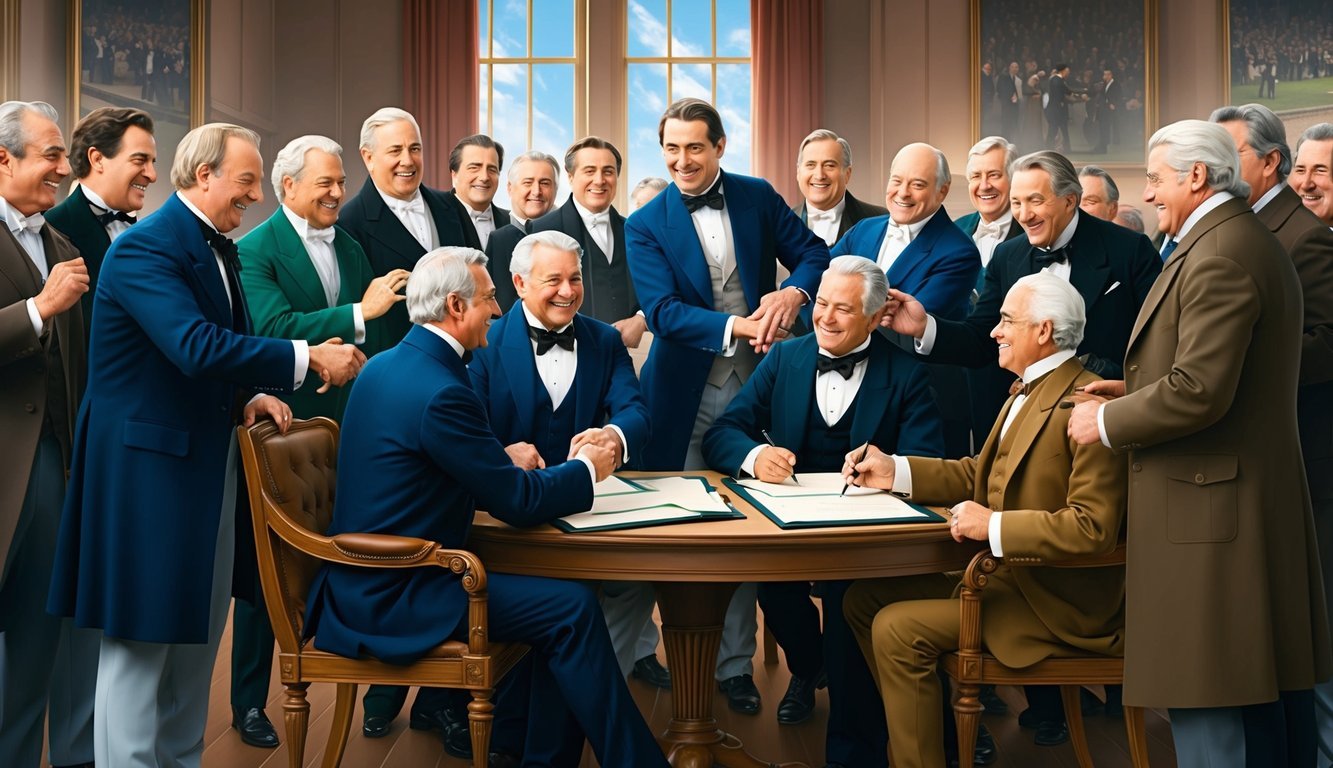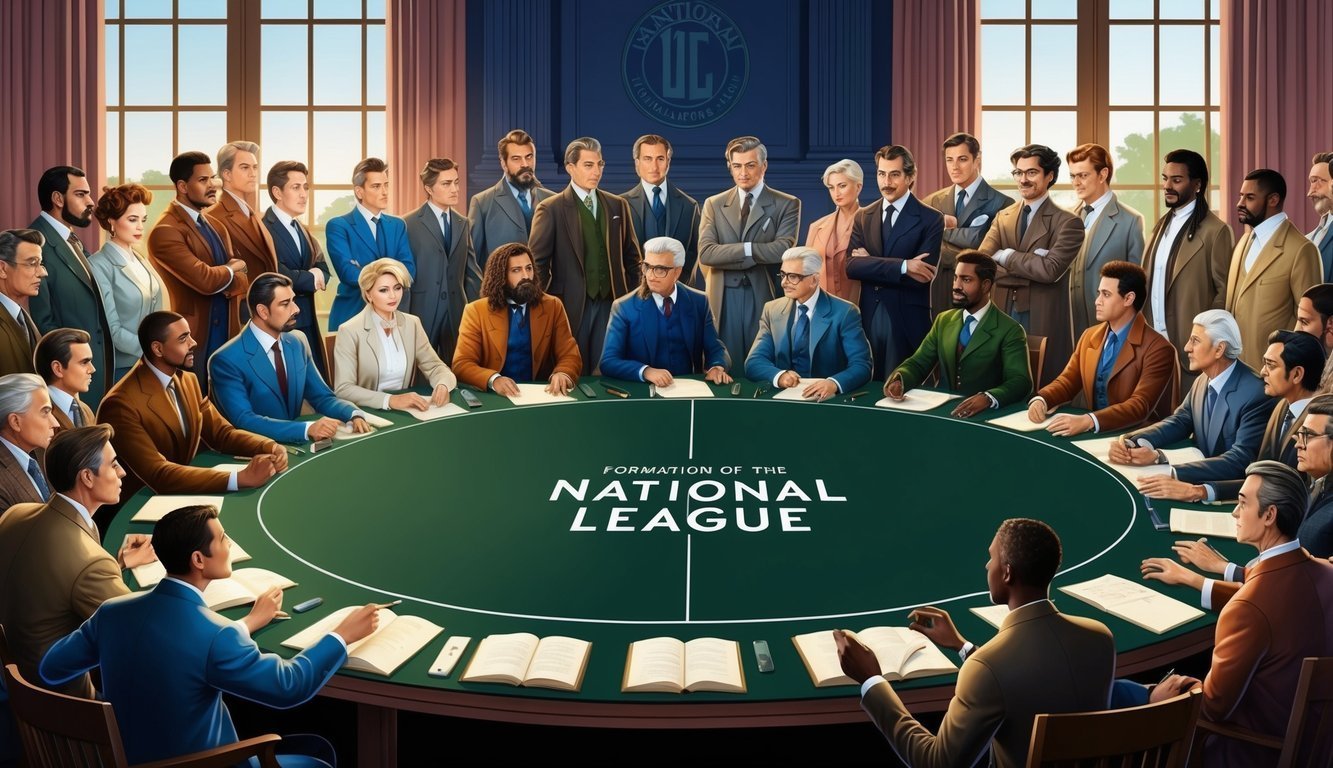The National League, founded on February 2, 1876, revolutionized the landscape of professional baseball in America.
It emerged as a response to the shortcomings of its predecessor, the National Association of Professional Base Ball Players.
The league’s formation marked a pivotal moment in sports history, establishing a structured and competitive environment for the nation’s favorite pastime.
The National League introduced unprecedented organization and stability to professional baseball, setting standards that would shape the sport for generations to come. It implemented a schedule of championship games, enforced player contracts, and established a system of governance that brought credibility to the game.
This new structure attracted talented players and passionate fans, laying the groundwork for baseball’s explosive growth in popularity.
The league’s eight founding teams represented major cities across the northeastern United States, including Boston, Chicago, Cincinnati, and New York.
These clubs competed fiercely for the league championship, captivating audiences and sparking intense rivalries that endure to this day.
The National League’s success paved the way for the formation of the American League in 1901, ultimately leading to the creation of Major League Baseball as we know it today.
The Founding of the National League

The National League emerged in 1876 as a revolutionary force in professional baseball.
It brought structure and stability to a sport plagued by gambling and inconsistent rules.
William Hulbert’s Vision
William Hulbert, owner of the Chicago White Stockings, spearheaded the creation of the National League.
He aimed to establish a more organized and respectable baseball organization.
Hulbert envisioned a league with strict rules and financial stability.
He wanted to eliminate the corruption that had tainted the National Association of Professional Base Ball Players.
Hulbert secretly met with owners from Boston, Philadelphia, and other key cities in late 1875.
Together, they plotted the formation of a new league that would reshape American baseball.
The Creation of a Governing Body
On February 2, 1876, the National League of Professional Baseball Clubs was officially born.
Eight charter teams joined: Chicago, Boston, Philadelphia, Hartford, St. Louis, Cincinnati, Louisville, and New York.
The league established a constitution and bylaws to govern its operations.
These rules set standards for player contracts, game schedules, and financial management.
Teams were required to complete their full schedule of games.
This helped ensure fair competition and financial stability for all clubs.
The National League’s formation marked the beginning of modern professional baseball.
It laid the groundwork for the sport’s growth into America’s national pastime.
Structural Growth and Changes

The National League underwent significant transformations in its early years.
Key developments shaped its structure, rules, and reach across the country.
Adopting the Constitution
The National League established its foundation by adopting a formal constitution in 1876.
This document outlined the league’s governance, membership criteria, and operational procedures.
It set clear guidelines for player contracts and club ownership.
The constitution prohibited gambling and alcohol sales at ballparks, aiming to improve the sport’s image.
It also introduced a standard schedule of games and a championship format.
These rules helped bring order to professional baseball and set the National League apart from its predecessors.
Establishment of Standards
The league implemented uniform standards to ensure fair competition and consistent gameplay.
Equipment specifications were standardized, including ball size and bat dimensions.
A set number of players per team was mandated.
Umpires gained more authority, with clearer guidelines for their role and decision-making process.
The league office took charge of creating and distributing official schedules.
This centralized approach helped reduce conflicts and ensure a balanced season for all teams.
Player salaries and contracts became more regulated, providing stability for both clubs and athletes.
Expansion Over Time
The National League grew from its initial eight teams in 1876.
New cities joined as baseball’s popularity spread across America.
In 1887, Pittsburgh and Indianapolis entered the league.
The 1890s saw further growth with Baltimore, Washington D.C., and Louisville gaining teams.
By 1900, the league had settled into an eight-team format that would last for decades.
This stability allowed for the development of intense rivalries and traditions.
The introduction of the American League in 1901 led to competition for players and markets.
This rivalry ultimately resulted in the first World Series in 1903, pitting the champions of each league against each other.
Economic Aspects and Attendance

The National League’s formation in 1876 brought significant changes to baseball’s financial landscape.
New business practices and fan engagement strategies emerged as the league sought to establish itself.
Business and Finances
The National League introduced structured player contracts and standardized schedules.
This move helped stabilize team finances and player salaries.
Owners now had more control over their costs and could better predict revenues.
Admission prices varied, but many teams charged around $1 for entry.
This fee helped cover operational expenses and player wages.
As the league grew, so did its revenue streams.
Teams began to explore additional income sources beyond ticket sales.
Television contracts were non-existent in the early days, but would later become a major revenue driver for the league.
The focus remained on gate receipts and local sponsorships during the National League’s initial years.
Fan Engagement and Stadiums
The National League prioritized fan experience to boost attendance.
Teams invested in stadium improvements, adding seating and amenities.
These enhancements aimed to attract more spectators and create a comfortable environment for watching games.
Promotional events and giveaways became popular ways to draw crowds.
Teams offered special discounts or themed nights to increase fan interest.
Baseball cards and team merchandise also gained popularity, providing additional revenue streams.
Attendance figures grew as the league established itself.
Fans embraced the more organized and competitive nature of National League games.
The regular season format allowed supporters to follow their favorite teams throughout the summer months.
Teams and Key Players

The National League’s founding clubs and early stars laid the groundwork for professional baseball’s growth.
These teams and players shaped the league’s identity and competitive spirit from the start.
Founding Clubs and Evolution
The National League began with eight charter members in 1876.
The Chicago White Stockings (now Cubs) and Boston Red Stockings (now Braves) were among the original teams.
The St. Louis Brown Stockings and Cincinnati Red Stockings also joined the league’s inaugural season.
Over time, the league expanded and evolved.
The New York Giants (now San Francisco Giants) entered in 1883, becoming a powerhouse.
The Brooklyn Dodgers (now Los Angeles Dodgers) joined in 1890, adding to the league’s fierce rivalries.
By the early 20th century, the St. Louis Cardinals and Philadelphia Phillies had become integral parts of the National League.
These teams helped establish the league’s enduring legacy and fan bases across the country.
Notable Player Contributions
Cap Anson of the Chicago White Stockings was one of the league’s first superstars.
His leadership and hitting prowess set early standards for excellence.
Pitcher Pud Galvin amazed fans with his durability, often pitching complete games.
In the late 1800s, John Montgomery Ward emerged as both a talented player and a labor advocate.
His efforts helped improve player rights and working conditions.
Cy Young’s dominant pitching in the early 1900s left an indelible mark on the sport.
Honus Wagner of the Pittsburgh Pirates dazzled fans with his all-around skills.
His batting titles and fielding prowess made him one of the league’s most beloved figures.
These early stars helped cement the National League’s place in America’s sporting landscape.
Challenges and Triumphs
The National League faced numerous obstacles in its early years but emerged stronger through perseverance and innovation.
Scandals threatened the league’s reputation, while victories cemented its place in American sports history.
Overcoming Disputes and Scandals
Gambling posed a significant threat to baseball’s integrity.
Players were caught betting on games, shaking public faith in the sport.
The league took swift action, banning several players for life to maintain credibility.
Contract disputes between players and owners created tension.
Some stars jumped to rival leagues for better pay, forcing the National League to improve working conditions.
The league also battled against monopoly accusations.
Critics claimed it unfairly dominated professional baseball, leading to legal challenges and public scrutiny.
In addition to the scrutiny surrounding its business practices, the league also faced hall of fame controversies in baseball, as debates erupted over the eligibility of certain players.
These controversies sparked passionate discussions among fans and analysts alike, further complicating the league’s efforts to maintain its image and uphold the integrity of the sport.
Ultimately, the combination of legal battles and ongoing debates contributed to a tumultuous era in baseball history.
Celebrating Victories and Milestones
The first National League pennant race in 1876 captivated fans nationwide.
Chicago emerged as the inaugural champions, setting the stage for decades of thrilling competition.
World Series matchups against the American League became an annual highlight.
These championship battles showcased the best talent and drew massive crowds.
The league expanded its reach, adding new teams and markets.
This growth solidified baseball as America’s pastime and boosted the sport’s popularity.
Star players like Cy Young and Honus Wagner became household names.
Their incredible performances on the field inspired a generation of young fans and aspiring athletes.
